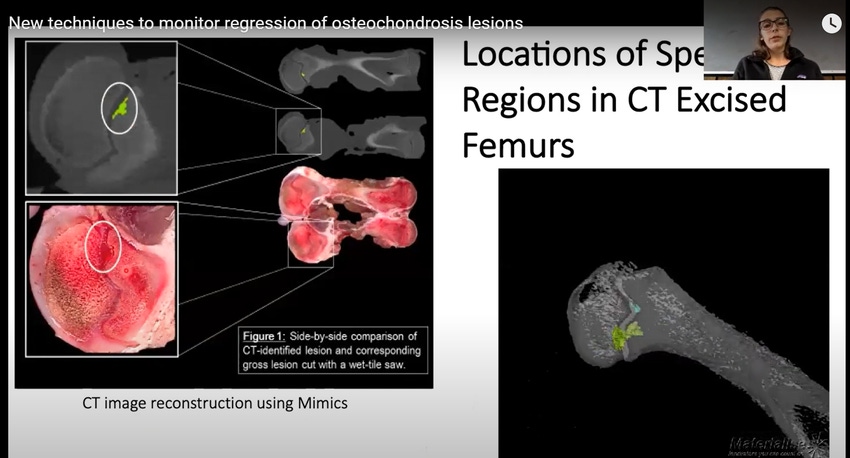Current work to focus on different dietary treatments to help regress number, size of lesions.

Osteochondrosis is the failure to convert growth cartilage into mineralized bone during the growing period. Cartilage that has not mineralized into bone is more susceptible to injury, including osteochondrotic lesions, which can be a painful contributor to swine lameness. Often occurring in rapidly growing pigs approaching market weight or breeding age, Brittney Kokinos says the disease can cause significant management issues and market ramifications.
"If they have severe lameness issues in their herds, due to osteochondrosis, the pigs themselves may or may not be able to get up on their own to get to the feed or water, so they might not grow very well, as well as potentially not being able to walk onto the trailer to be able to be sent to market when they reach market weight, because there's more body weight pushing on these regions of interest," says Kokinos.
An animal nutrition graduate student in the Department of Animal and Dairy Sciences at the University of Wisconsin-Madison, Kokinos and other researchers in Thomas Crenshaw's lab have been investigating the use of an osteochondrotic model to test different dietary interventions to learn which treatments regress these lesions in a quicker, more cost-effective manner to prevent and reduce lameness in swine.
While the osteochondrotic model was developed quite a few years ago to study humpback pigs, where retained cartilage occurs in the spinal column, Kokinos says the current work at the lab is focused on different dietary treatments to help regress the number and size of lesions. To do this, the lab first had to incorporate three-dimensional imaging to shed new light on the analysis of the progression or regression of osteochondrotic lesions in pigs.
"When I talk about these lesions, and CT scans, mineralized bone in CT shows up in a lighter color, so then we're able to see the growth plate where it's darker," Kokinos says. "And then if we look over at the MRI, it's a little different, where we get a little bit more detail of soft tissue with cartilage and mineralized bone being lighter or darker."
Kokinos says with the lab's computing software, they're then able to reconstruct three dimensional images, to be able to visualize and quantify the number, volume, surface area and location, as well as density of the lesions.
"Through which we can use this masking tool where we are able to decipher out where it's mineralized and what is not mineralized, where it's that retained cartilage, which is that lesion," Kokinos says.
In a previous cross-sectional study, the lab was able to compare pigs, a subset of pigs at 12 weeks of age, as well as a subset of pigs at 24 weeks of age. Researchers were able to determine differences between the number of lesions, the volume and the surface area at two different time points.
In addition, Kokinos says the lab has worked with the same software, to be able to look at the specific locations that these lesions occur in to confirm that the locations they're finding within the software relates to the actual bone that was scanned.
"So, we're able to go in and find the coordinates within the software and go in and cut that bone at that location and find the lesion within the actual bone," Kokinos says.
Lastly, the researchers are able to determine the region of interests in density measurements of subchondral bone.
"We're able to set these different regions of interest such as one, two, three, four, five, around the lesion itself and within it, and we're able to set different densities to be able to measure the bone underneath," Kokinos says.
Ultimately, Kokinos says the lab is working on three dimensional reconstructions of CT and MRI images to allow for detailed progression, or detailed non-invasive imaging analysis of regions of interest during the progression or regression of osteochondrotic lesions in pigs.
"Through which we hope to be able to induce or produce different dietary treatments that would be able to regress these lesions to be able to contribute to the nutritional needs of the animal, as well as being able to help producers mitigate the observations they see within their herd, to prevent financial losses, as well as preventing lameness within their herds," Kokinos says.
About the Author(s)
You May Also Like





